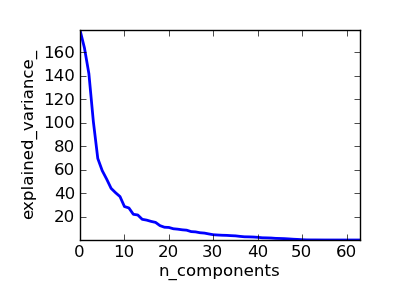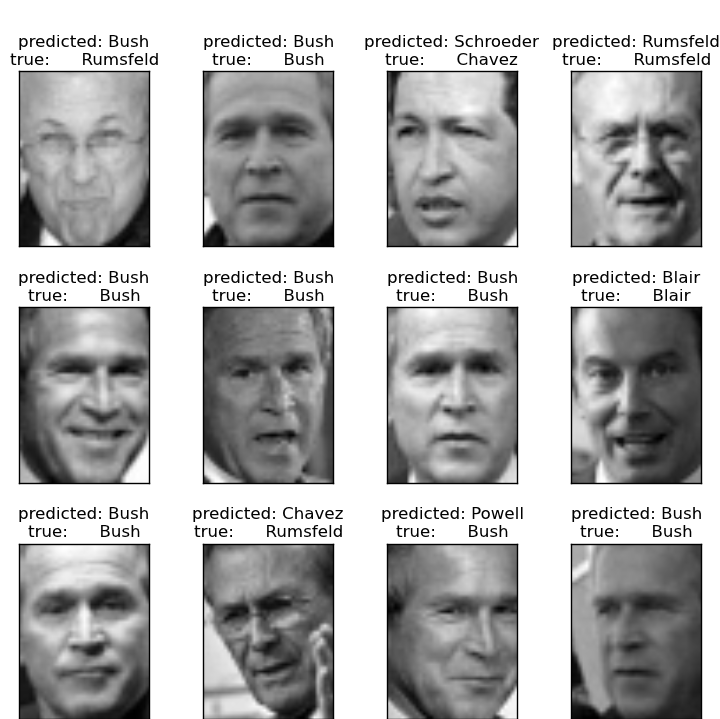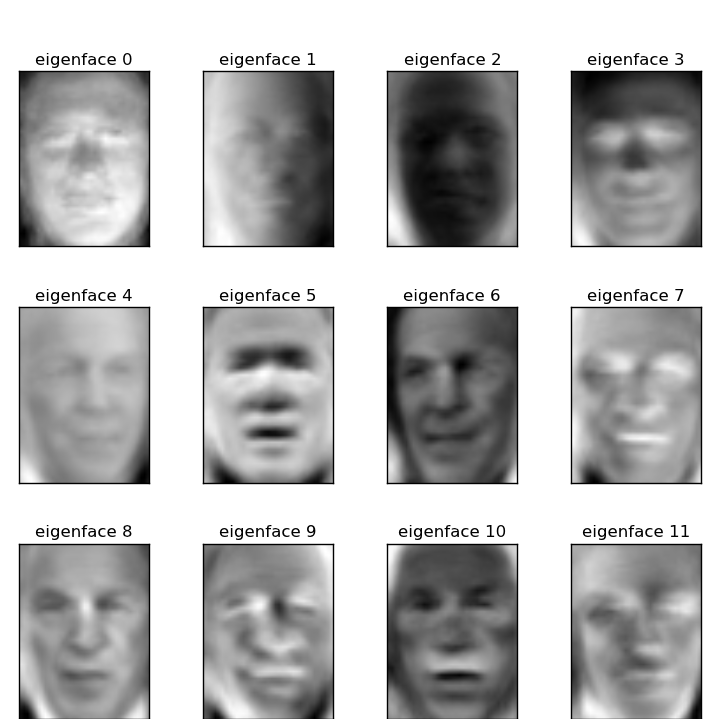2.2.5. Putting it all together¶
2.2.5.1. Pipelining¶
We have seen that some estimators can transform data, and some estimators can predict variables. We can create combined estimators:

from sklearn import linear_model, decomposition, datasets, cross_validation
logistic = linear_model.LogisticRegression()
pca = decomposition.PCA()
from sklearn.pipeline import Pipeline
pipe = Pipeline(steps=[('pca', pca), ('logistic', logistic)])
digits = datasets.load_digits()
X_digits = digits.data
y_digits = digits.target
################################################################################
# Plot the PCA spectrum
pca.fit(X_digits)
pl.figure(1, figsize=(4, 3))
pl.clf()
pl.axes([.2, .2, .7, .7])
pl.plot(pca.explained_variance_, linewidth=2)
pl.axis('tight')
pl.xlabel('n_components')
pl.ylabel('explained_variance_')
################################################################################
# Prediction
scores = cross_validation.cross_val_score(pipe, X_digits, y_digits, n_jobs=-1)
from sklearn.grid_search import GridSearchCV
n_components = [10, 15, 20, 30, 40, 50, 64]
Cs = np.logspace(-4, 4, 16)
#Parameters of pipelines can be set using ‘__’ separated parameter names:
estimator = GridSearchCV(pipe,
dict(pca__n_components=n_components,
logistic__C=Cs),
n_jobs=-1)
estimator.fit(X_digits, y_digits)
# Plot the PCA spectrum
pca.fit(X_digits)
2.2.5.2. Face recognition with eigenfaces¶
The dataset used in this example is a preprocessed excerpt of the “Labeled Faces in the Wild”, aka LFW:
"""
===================================================
Faces recognition example using eigenfaces and SVMs
===================================================
The dataset used in this example is a preprocessed excerpt of the
"Labeled Faces in the Wild", aka LFW_:
http://vis-www.cs.umass.edu/lfw/lfw-funneled.tgz (233MB)
.. _LFW: http://vis-www.cs.umass.edu/lfw/
Expected results for the top 5 most represented people in the dataset::
precision recall f1-score support
Gerhard_Schroeder 0.91 0.75 0.82 28
Donald_Rumsfeld 0.84 0.82 0.83 33
Tony_Blair 0.65 0.82 0.73 34
Colin_Powell 0.78 0.88 0.83 58
George_W_Bush 0.93 0.86 0.90 129
avg / total 0.86 0.84 0.85 282
"""
print __doc__
from time import time
import logging
import pylab as pl
from sklearn.cross_validation import train_test_split
from sklearn.datasets import fetch_lfw_people
from sklearn.grid_search import GridSearchCV
from sklearn.metrics import classification_report
from sklearn.metrics import confusion_matrix
from sklearn.decomposition import RandomizedPCA
from sklearn.svm import SVC
# Display progress logs on stdout
logging.basicConfig(level=logging.INFO, format='%(asctime)s %(message)s')
###############################################################################
# Download the data, if not already on disk and load it as numpy arrays
lfw_people = fetch_lfw_people(min_faces_per_person=70, resize=0.4)
# introspect the images arrays to find the shapes (for plotting)
n_samples, h, w = lfw_people.images.shape
# fot machine learning we use the 2 data directly (as relative pixel
# positions info is ignored by this model)
X = lfw_people.data
n_features = X.shape[1]
# the label to predict is the id of the person
y = lfw_people.target
target_names = lfw_people.target_names
n_classes = target_names.shape[0]
print "Total dataset size:"
print "n_samples: %d" % n_samples
print "n_features: %d" % n_features
print "n_classes: %d" % n_classes
###############################################################################
# Split into a training set and a test set using a stratified k fold
# split into a training and testing set
X_train, X_test, y_train, y_test = train_test_split(
X, y, test_fraction=0.25)
###############################################################################
# Compute a PCA (eigenfaces) on the face dataset (treated as unlabeled
# dataset): unsupervised feature extraction / dimensionality reduction
n_components = 150
print "Extracting the top %d eigenfaces from %d faces" % (
n_components, X_train.shape[0])
t0 = time()
pca = RandomizedPCA(n_components=n_components, whiten=True).fit(X_train)
print "done in %0.3fs" % (time() - t0)
eigenfaces = pca.components_.reshape((n_components, h, w))
print "Projecting the input data on the eigenfaces orthonormal basis"
t0 = time()
X_train_pca = pca.transform(X_train)
X_test_pca = pca.transform(X_test)
print "done in %0.3fs" % (time() - t0)
###############################################################################
# Train a SVM classification model
print "Fitting the classifier to the training set"
t0 = time()
param_grid = {
'C': [1e3, 5e3, 1e4, 5e4, 1e5],
'gamma': [0.0001, 0.0005, 0.001, 0.005, 0.01, 0.1],
}
clf = GridSearchCV(SVC(kernel='rbf', class_weight='auto'), param_grid)
clf = clf.fit(X_train_pca, y_train)
print "done in %0.3fs" % (time() - t0)
print "Best estimator found by grid search:"
print clf.best_estimator_
###############################################################################
# Quantitative evaluation of the model quality on the test set
print "Predicting the people names on the testing set"
t0 = time()
y_pred = clf.predict(X_test_pca)
print "done in %0.3fs" % (time() - t0)
print classification_report(y_test, y_pred, target_names=target_names)
print confusion_matrix(y_test, y_pred, labels=range(n_classes))
###############################################################################
# Qualitative evaluation of the predictions using matplotlib
def plot_gallery(images, titles, h, w, n_row=3, n_col=4):
"""Helper function to plot a gallery of portraits"""
pl.figure(figsize=(1.8 * n_col, 2.4 * n_row))
pl.subplots_adjust(bottom=0, left=.01, right=.99, top=.90, hspace=.35)
for i in range(n_row * n_col):
pl.subplot(n_row, n_col, i + 1)
pl.imshow(images[i].reshape((h, w)), cmap=pl.cm.gray)
pl.title(titles[i], size=12)
pl.xticks(())
pl.yticks(())
# plot the result of the prediction on a portion of the test set
def title(y_pred, y_test, target_names, i):
pred_name = target_names[y_pred[i]].rsplit(' ', 1)[-1]
true_name = target_names[y_test[i]].rsplit(' ', 1)[-1]
return 'predicted: %s\ntrue: %s' % (pred_name, true_name)
prediction_titles = [title(y_pred, y_test, target_names, i)
for i in range(y_pred.shape[0])]
plot_gallery(X_test, prediction_titles, h, w)
# plot the gallery of the most significative eigenfaces
eigenface_titles = ["eigenface %d" % i for i in range(eigenfaces.shape[0])]
plot_gallery(eigenfaces, eigenface_titles, h, w)
pl.show()
 |
 |
| Prediction | Eigenfaces |
Expected results for the top 5 most represented people in the dataset:
precision recall f1-score support
Gerhard_Schroeder 0.91 0.75 0.82 28
Donald_Rumsfeld 0.84 0.82 0.83 33
Tony_Blair 0.65 0.82 0.73 34
Colin_Powell 0.78 0.88 0.83 58
George_W_Bush 0.93 0.86 0.90 129
avg / total 0.86 0.84 0.85 282
2.2.5.3. Open problem: Stock Market Structure¶
Can we predict the variation in stock prices for Google?
